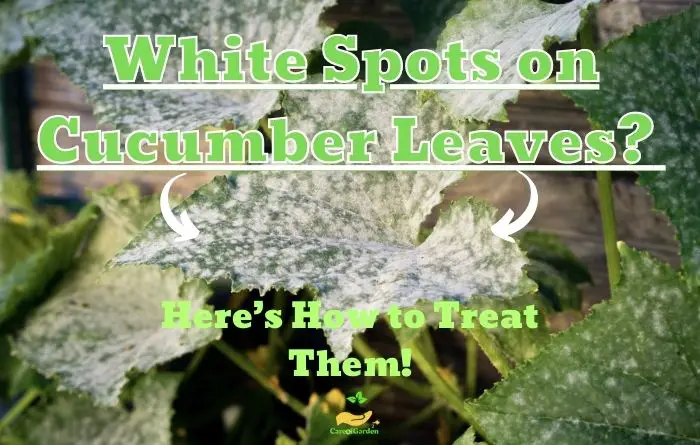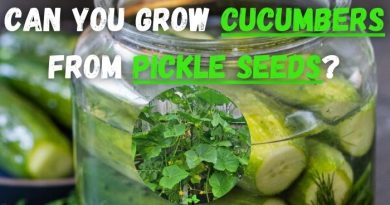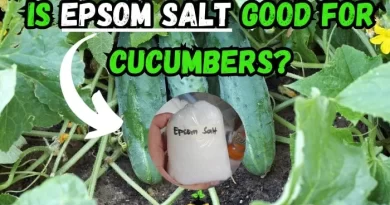White Spots on Cucumber Leaves: How To Quickly Eliminate Them!
Recently, I noticed that on the leaves of my cucumber plants, white spots suddenly began to appear, which made me look for the reasons for this clearly not “positive” phenomenon.
After I have done my research, consulted fellow gardeners, and tested out various treatments, I will discuss the causes of this problem and provide practical solutions to prevent and treat white cucumber leaves.
White spots on cucumber leaves are caused by several factors. Fungal diseases such as powdery mildew and downy mildew are common culprits, thriving in humid conditions. Other potential causes include viral infections like cucumber mosaic virus, nutrient deficiencies, or even pests. To address this issue, start by inspecting the leaves and removing affected ones. Maintain proper ventilation, ensure adequate sunlight, and avoid overwatering. Consider applying organic fungicides or seeking natural remedies to combat fungal diseases.
Common causes of white spots on cucumber leaves
The surface of cucumber plant leaves can be used to indicate plant health. A common problem is sometimes plants have white spots on their leaves, which is something to be concerned about.
In this section, we will discuss in detail the various causes that can lead to the appearance of white spots on cucumber leaves, along with control and treatment measures for each of them.
1. Fungal diseases
Fungal diseases are another common cause of white spots on cucumber leaves. Many fungi attack cucumber plants and cause damage to the leaves, resulting in chlorosis (white spots on the leaves).
Powdery mildew
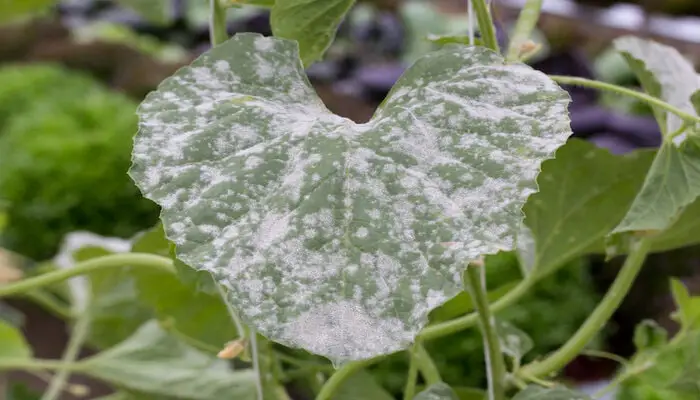
Powdery mildew is one of the most common fungal diseases on many plants, and it causes white spots on cucumber leaves. These spots quickly increase in size, drastically affecting the plant.
Powdery mildew is a fungal disease that occurs mainly in the summer, around the end of July. The fungus can affect both cucumbers in open ground and cucumbers grown in greenhouses. It thrives in dry, warm temperatures, unlike the majority of fungi.
Symptoms
Powdery mildew is favored by warm and dry summer weather. The fungal disease can be recognized by a white, moldy coating. This topping looks like someone has sprinkled flour or dust over the cucumber leaves.
The first signs of the disease can be seen on the underside of the cucumber leaf , where an inconspicuous white powdery coating appears (sporulation of the fungus).
At the same time, characteristic white spots form on the upper side of the cucumber leaf (they seem to be sprinkled with white powder), which gradually merge and darken (acquire a more brown tint).
In the future, the fungus can then spread to the undersides of the leaves and also infect the stems and the fruits of the cucumber plants.
As a rule, the fruits themselves (cucumbers) are not damaged (there is no plaque on them), however, due to deformation and leaf fall, cucumbers can get sunburned, become smaller and wither (become less juicy).
The fungus penetrates the upper layers of plants and feeds on their cell sap. If the gardener does not intervene, the affected parts of the plant will dry up, and the cucumber plant will wither. In the worst case, the cucumber plant can even die.
Causes of cucumber plant infection with powdery mildew
- Environmental Conditions: Powdery mildew tends to develop in environments with moderate temperatures (60-80°F or 15-27°C) and high humidity. Dry and warm days followed by cool nights create favorable conditions for the disease.
- Crowded Planting and Poor Air Circulation: Overcrowded planting and lack of adequate spacing between plants restrict air movement, leading to increased humidity around the foliage. This creates an ideal environment for powdery mildew development.
- Susceptible Cucumber Varieties: Some cucumber varieties are more susceptible to powdery mildew than others. Planting susceptible varieties increases the likelihood of infection.
- Infected Plant Material: Introducing infected cucumber transplants or using contaminated tools and equipment can introduce the powdery mildew pathogen to a previously healthy garden or crop.
- Residual Infection: Powdery mildew can overwinter on plant debris, such as fallen leaves or stems, and serve as a source of infection for the following growing season.
- Weeds as Hosts: Certain weed species, such as lamb’s quarters or pigweed, can harbor powdery mildew and serve as a reservoir for the pathogen. Weeds in or near cucumber plantings can contribute to disease spread.
Control and treatment measures
To control powdery mildew, it’s recommended to use specific fungicides for this disease, following the recommended dosage and application instructions.
- Spray the cucumber leaves with a solution of skim milk. This will remove the powdery mildew and prevent its spread. Treat them with sodium silicate.
- Use lactic acid bacteria, they are gentle on cucumbers, but merciless to the fungus. You can use kefir (better even one whose expiration date has expired) or yogurt.
- Pour the manure with cold water, leave it for 3 days. Separate the solution and dilute it with water (1:10). Spray the bushes with this mixture. Use herbs, for example, defend nettles.
- Treat plants in open soil with a solution of colloidal sulfur 20%, in greenhouses 40%. Regular treatment with a mixture of soap and soda (1: 1) will help.
- Try treating cucumber leaves with weed infusion. Grind, fill with water, leave to ferment for 2 days, and you can use it for spraying.
In case of infestation, in addition to the chemical application, affected leaves must be removed and discarded to prevent the fungus from spreading.
Maintain good air circulation around the plants and avoid watering the leaves, as humidity favors the development of powdery mildew. There are some powdery mildew-resistant varieties on the market.
Preventive Methods
- Stick to crop rotation, it will help prevent the fungus from persisting in the soil.
- Clear the area regularly of weeds and debris.
- Treat the soil after harvesting your cucumbers.
- Protect your cucumber plants from temperature extremes.
- Water the cucumber with warm water only.
- Do not overdo it with nitrogen supplements.
Table with cucumber varieties known for their resistance to powdery mildew:
| Cucumber Variety | Resistance to Powdery Mildew |
|---|---|
| ‘Diva’ | High resistance |
| ‘Fanfare’ | High resistance |
| ‘Salad Bush’ | High resistance |
| ‘Sweet Success’ | High resistance |
| ‘Tasty Green’ | High resistance |
| ‘Marketmore 76’ | Moderate resistance |
| ‘Poinsett 76’ | Moderate resistance |
| ‘Spacemaster’ | Moderate resistance |
| ‘Lemon’ | Moderate resistance |
| ‘Bush Champion’ | Moderate resistance |
| ‘Summer Dance’ | Moderate resistance |
| ‘Sweeter Yet’ | Moderate resistance |
| ‘Amber’ | High resistance |
| ‘Bimbostar’ | High resistance |
| ‘Charlotte’ | High resistance |
| ‘Conny’ | High resistance |
| ‘Cubella’ | High resistance |
| ‘Excelsior’ | High resistance |
| ‘Hok’ | High resistance |
| ‘Libelle’ | High resistance |
| ‘Schubert’ | High resistance |
| ‘Stimora’ | High resistance |
| ‘Zicron’ | High resistance |
| ‘Amazone’ | Moderate resistance |
| ‘Bella’ | Moderate resistance |
| ‘Cordoba’ | Moderate resistance |
| ‘Dominica’ | Moderate resistance |
| ‘Euphya’ | Moderate resistance |
| ‘Flamingo’ | Moderate resistance |
| ‘Hayat’ | Moderate resistance |
| ‘Midios’ | Moderate resistance |
| ‘Pasca’ | Moderate resistance |
| ‘Persika’ | Moderate resistance |
| ‘Solverde’ | Moderate resistance |
| ‘Sudica’ | Moderate resistance |
Cucumber “White” Mosaic Virus
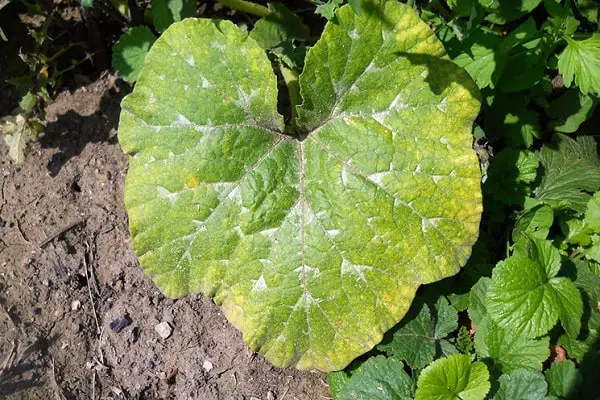
The Cucumber Mosaic Virus (CVM) is a virus that attacks cucumber tissues at the cellular level, causing the chlorophyll to be destroyed. It enters cucumber tissues through damaged areas of the plant.
You can recognize the disease by the white spots with a yellowish tint that appear on the surface of your cucumber leaves. The disease occurs primarily with sudden changes in temperature or with a long hot period with a temperature above 77°F (+25 °C).
The small aphids that spread the cucumber mosaic virus are to blame. Due to the large number of host plants, transmission occurs very quickly.
An infected cucumber slows down growth; the cucumber fruits become deformed and acquire an unpleasant taste.
Symptoms
Obvious changes in cucumber: they stop developing, white spots with a yellow tint appear on young leaves, damage merges into a large spot as the disease progresses, cucumbers become deformed and lose their color.
These are mostly light white spots, which can vary greatly depending on the strain of the virus. These spottings can also appear on the cucumbers, and wart-like structures also form here. The good thing is that the virus cannot survive on dead cucumber plant parts.
The initial symptoms start to show after 10 to 14 days. Wilting happens at temperatures below 68°F (20°C), and the typical mosaic white spots appear at temperatures above 75°F (24°C).
Gardeners have come up with many ways to treat this disease, but they all need consistent action and the attention of gardeners.
Causes
- Viral Transmission: CMV is primarily transmitted through infected plant material, such as seeds, transplants, or infected tools. It can also be spread by aphids and other insect vectors that feed on infected plants and then transmit the virus to healthy plants.
- Infected Weeds: Weeds can serve as reservoirs for CMV, harboring the virus and providing a source of infection for nearby cucumber plants. Weeds such as chickweed and nettle can host CMV.
- Bad Agricultural Practices: Poor sanitation and improper handling of infected plants or tools can contribute to the spread of CMV. Failure to remove and destroy infected plant debris can allow the virus to persist and infect future crops.
- Aphid Infestation: Aphids are the primary vectors for CMV transmission. When they feed on infected cucumber leaves, they acquire the virus and can subsequently transmit it to healthy cucumber plants during feeding.
- Use of Contaminated Tools: CMV can be mechanically transmitted through activities such as pruning, grafting, or using contaminated tools. This can occur if infected sap or plant tissues come into contact with healthy plants.
- Lack of Resistant Varieties: Planting susceptible cucumber varieties increases the risk of CMV infection. Lack of resistance in the chosen varieties leaves them vulnerable to the virus.
Treatment
For the treatment of cucumber mosaic virus specifically, the following measures can be taken:
- Use Virus-Free Plant Material: Start with disease-free seeds or transplants from reliable sources. Using virus-free plant material helps prevent the introduction of CMV into the growing area.
- Control Aphid Populations: Aphids are primary vectors for CMV transmission. Implement aphid control measures such as applying insecticidal soaps, oils, or using biological control agents to reduce aphid populations. This reduces the likelihood of CMV transmission from aphids to cucumber plants.
- Remove Infected Weeds: Eliminate nearby weeds that may serve as hosts for CMV. Weeds can harbor the virus and act as a source of infection for cucumber plants. Regular weeding and removal of infected weeds can help prevent CMV spread.
Preventive Methods
- Remove weeds from the area regularly.
- Purchase cucumber seeds only from experienced sellers.
- After harvesting, destroy all plant residues.
- Do not plant cucumber bushes too close to each other.
- Do not water your cucumbers with cold water and do not allow sudden changes in temperature.
- Uproot infected bushes and burn them.
- Carry out all the necessary actions to destroy aphids, as they are considered a carrier of the disease. Treat all healthy plants.
Table showcasing cucumber varieties that are known to have resistance to cucumber mosaic virus (CMV):
| Cucumber Variety | Resistance to Cucumber Mosaic Virus |
|---|---|
| ‘Beit Alpha’ | Resistant |
| ‘Little Leaf’ | Resistant |
| ‘Bush Slicer’ | Resistant |
| ‘Fanfare’ | Resistant |
| ‘Marketmore 76’ | Resistant |
| ‘Sweet Success’ | Resistant |
| ‘Dasher II’ | Resistant |
| ‘Poinsett 76’ | Resistant |
| ‘Rocky’ | Resistant |
| ‘Slicemaster’ | Resistant |
2. Pests
Pest bites on the leaves cause small white spots. Some insects, such as spider mites, leafhoppers, and thrips, feed on the leaves, causing damage and leaving visible white spots.
Spider Mites

Mites are small arachnids that feed on the sap of plants, leaving the leaves with a white-painted appearance. They are pests of difficult control that are brought by the wind or even on our clothes. In addition to white spots, another symptom is the presence of fine webs on infested cucumber leaves.
It is impossible to immediately notice a spider mite because it is very small in size, like a black dot. Hiding on the underside of the underside of the cucumber leaves and weaving a cobweb.
They are noticed already when light, almost white spots appear on the upper side of the cucumber leaves and a cobweb is visible between the petioles and stems. Spider mites attack cucumber plants in hot weather with insufficient air humidity.
Cucumbers grown in open ground are prone to spider mite infection. It feeds on the sap of plants and causes the green mass to dry up. Cucumbers grow small, deformed. If you do not treat the plants against the parasite in time, you can lose the crop completely.
Symptoms
The presence of this signs indicates the appearance of a spider mite on cucumbers:
- White spots on the cucumber leaf blade;
- A thin cobweb on the back surface of the leaves;
- Slowing down of cucumber plant growth;
- Yellowing of green mass.
Causes
The spider mite is most commonly found on plants and they appear when the temperature is too high and the weather is dry. On the underside of the plates (later on the stems and ovaries), medium-sized white spots and a barely noticeable thin cobweb appear.
Cucumber plant development slows down. The white edges on cucumber leaves curl and dry out over time.
Control and treatment measures
There are several ways to prevent and control pests, the main one being regular inspection of plants, and visually identifying any signs of infestation.
- Biological methods: It is the use of natural enemies of pests, such as ladybugs, lacewings, and predatory mites, to feed on unwanted insects. You can buy these insects or attract these predators by planting certain plants, such as wildflowers.
- Management methods: Adopt good practices in culture, these practices minimize pest infestation. We’re talking about crop rotation, spacing plants properly (to allow for good air circulation), removing unwanted plants, and regularly cleaning the garden to eliminate plant debris that could harbor pests.
- Chemical methods: In cases of severe infestations, the use of insecticides may be necessary. It is vital to choose safe and suitable products and to follow the instructions for use carefully, taking into account the safety of the plants, animals, people, and other beings that inhabit the garden.
Preventive Methods
To prevent the appearance of a spider mite, it is necessary to carry out all preventive and processing measures in advance (if a web was noticed on plants last year, then this spring it is necessary to spray with drugs).
- After harvesting, burn all parts of the cucumber.
- Before planting your cucumber, dig up the area intended for growing cucumbers, because pests hibernate in the ground. Pull out all weeds, do not leave anything superfluous on the soil.
- At all stages of growth and development of this vegetable crop, inspect all parts of the bushes, if you find infected areas, immediately remove them and burn them.
- Alternate planting cucumbers with tomatoes. Treat infected plants with special means.
Table showcasing cucumber varieties that are known to have resistance to spider mites:
| Cucumber Variety | Resistance to Spider Mites |
|---|---|
| ‘Diva’ | Resistant |
| ‘Fanfare’ | Resistant |
| ‘Salad Bush’ | Resistant |
| ‘Sweet Success’ | Resistant |
| ‘Tasty Green’ | Resistant |
| ‘Marketmore 76’ | Resistant |
| ‘Poinsett 76’ | Resistant |
| ‘Spacemaster’ | Resistant |
| ‘Lemon’ | Resistant |
| ‘Bush Champion’ | Resistant |
| ‘Summer Dance’ | Resistant |
| ‘Sweeter Yet’ | Resistant |
3. Nutrients Deficiency
One of the main causes of white spots on the leaves (also called chlorosis) of cucumbers is nutrient deficiency. Lack of nutrients in the soil or via fertilization will negatively affect the healthy growth of cucumber plants.
Table outlining nutrient deficiencies that can cause white spots on cucumber leaves:
| Nutrient Deficiency | Symptoms/Effects on Cucumber Leaves |
|---|---|
| Nitrogen | Pale or yellowish leaves with white spots near leaf edges. |
| Phosphorus | Leaves with white or yellow spots, often accompanied by purple or reddish discoloration. |
| Potassium | White or yellow spots on older leaves, followed by browning and necrosis. |
| Magnesium | Interveinal chlorosis (yellowing) with white spots between leaf veins. |
| Calcium | White spots on leaves, along with leaf curling and tip burn. |
| Iron | Leaves with pale yellow or white spots, typically starting from the base. |
| Manganese | Light green or yellow spots on leaves, sometimes accompanied by brown necrotic areas. |
| Zinc | White spots or bleached areas on young leaves, stunted growth. |
| Copper | White or grayish spots on young leaves, distorted growth. |
Nitrogen deficiency
Nitrogen is an essential nutrient, playing a major role in leaf development and cucumber growth. When nitrogen is deficient, cucumber leaves turn white or pale yellow. Yellowing begins to appear first on older leaves.
Treatment measures
Nitrogen is one of the most abundant and easy to supplement-nutrients. To treat nitrogen deficiency, apply fast-release nitrogen fertilizers or use nitrogen-rich organic fertilizers (such as earthworm humus, cured manure, and compost).
When applying the fertilizer, carefully follow the recommended dosage instructions and fertilize properly, applying it around the roots of the plants. In addition, it is essential to ensure adequate irrigation to help with the absorption of nutrients by the roots.
Magnesium deficiency
Magnesium is an essential micronutrient active in photosynthesis and chlorophyll production in plants. Magnesium deficiency can result in white or yellowish spots on cucumber leaves.
Treatment measures
To treat magnesium deficiency, it’s recommended to apply magnesium-rich fertilizers. Apply the fertilizer around the plant’s roots, following the recommended dosage instructions. Ensure the soil pH is correct, as excessive acidity can make it difficult for the roots to absorb magnesium.
Iron deficiency
Iron deficiency can lead to the appearance of white spots on cucumber leaves, especially between the leaf veins. It is a not very common deficiency.
Treatment measures
To treat iron deficiency, apply iron-chelated fertilizers. These fertilizers are specially formulated so that the iron is readily available to plants, regardless of soil pH. It is worth emphasizing the importance of checking soil drainage, as excess water makes it difficult for the roots to absorb iron.
4. Sunburn
Direct and prolonged exposure to the intense sun can cause leaf burn, leading to bleaching and white spots on cucumber leaves. After planting seedlings of cucumbers in the soil, white spots may appear on the leaves due to a small amount of light.
In almost all cases, this cause occurs in greenhouses, but sometimes in open ground, especially if the area allocated for growing cucumbers is shady. It is recommended to plant cucumbers in a well-lit area so that the plant does not experience a shortage of sunlight.
Cucumbers are dense plants, so the upper sheets have time to be saturated with lighting, and the light reaches the lower ones weakly.
Control and treatment measures
To protect the plants from excessive sun exposure, just provide adequate shade, this is especially crucial on hotter days. There are several covers specially manufactured for this purpose.
Use these shade covers or relocate your plants to places that receive filtered or even indirect sunlight. Check that the amount of water during irrigation is sufficient to avoid water stress, which can aggravate the effects of sun exposure.
5. Improper soil pH
The leaves of cucumbers also turn white due to the increased acidity of the soil. In highly acidic soils, certain nutrients required for healthy leaf development, such as phosphorus and magnesium, can become less available to cucumbers. This nutrient lockout can result in nutrient deficiencies and subsequent leaf discoloration, including white or pale leaves.
Also, the pH of the soil affects the availability and uptake of various nutrients. Cucumbers prefer slightly acidic to neutral soil conditions (pH range of 6.0 to 7.0). When the soil becomes excessively acidic (below pH 6.0), it can disrupt the uptake of essential nutrients, potentially leading to white or discolored leaves.
In such bad soil, cucumbers may cease to develop altogether. It is necessary to exclude this option or confirm it by checking and testing the acidity of the soil.
Take some soil and place it in a container. Fill it with distilled water until the consistency of sour cream is obtained. Add 1 tsp. soda. If bubbles begin to appear and a hiss occurs, then the soil is too acidic.
When preparing the soil before planting seedlings or sowing, any deoxidizers should be added to determine the acidic reaction of the soil.
Treatment
To lower the acidity level of the soil, use wood ash:
- For 5 liters of water, take 250 g of wood ash and mix the ingredients.
- Pour this solution when planting seedlings of cucumbers.
| Method | Description |
|---|---|
| Liming | Applying agricultural lime to the soil to raise the pH level. |
| Dolomitic Lime | Using dolomitic lime to raise pH and provide magnesium. |
| Wood Ash | Applying wood ash, which contains potassium and raises pH. |
| Organic Matter | Adding compost or well-rotted manure to improve soil quality. |
| pH-Adjusting Fertilizers | Using fertilizers specifically formulated to adjust soil pH. |
6. Aging
Plant aging is the only factor when cucumber leaves become covered with white spots for reasons beyond the gardener’s control. Here you can try to make complex top dressing, perhaps they will help to delay the moment of removal of fertile plants.
However, the natural old age of the cucumber plants occurs after the harvest. If the plant began to dry out earlier, then the reason is not aging.
How to Prevent Cucumber Leaves from Turning White
Preventing cucumber leaves from turning white is easy, just follow good handling practices.
Here are some tips and strategies you can follow to keep your cucumber leaves healthy and free of white spots.
1. pH of the soil
Soil pH plays a key role for plants. pH is a measure of acidity or alkalinity. Soil pH level affects nutrient availability to plants. In the specific case of growing cucumbers, keeping the soil pH slightly acidic is essential to ensure efficient nutrient absorption and prevent development problems.
Cucumber plants have a preference for slightly acidic soils with a pH between 6.0 and 6.8. In this pH range, essential nutrients for cucumber growth, such as nitrogen, phosphorus, potassium, and micronutrients, are readily available for the roots to absorb.
When soil pH deviates from this ideal range, unavailability or excess of certain nutrients can occur, negatively affecting the growth and productivity of cucumber plants.
Maintaining proper soil pH can be achieved through proper management practices. If the pH is below the recommended level, it may be necessary to apply acidity correctors, such as dolomitic limestone, to raise the pH.
On the other hand, if the pH is too high, it may be necessary to apply acidifying materials such as sulfur and organic matter. The best way to monitor this parameter is to perform regular soil pH tests.
2. Watering
Providing adequate watering is critical to preventing cucumber leaves from turning white or showing other problems. Cucumber plants need the right amount of water to grow optimally, both too much and too little are harmful.
Excess moisture can lead to fungal diseases such as powdery mildew and Fusarium wilt. While cucumbers that receive less than ideal amounts will have a problem absorbing nutrients and carrying out photosynthesis correctly.
Watering tips
Water the plants regularly, keeping the soil below the surface moist but not soggy.
Apply water directly to the soil, close to the base of the plants, avoiding wetting the leaves, stems, flowers, and fruits; this measure contributes to maintaining good humidity and air circulation, preventing the appearance of fungal diseases.
A great measure is to use irrigation systems that supply water in a gradual and controlled way, such as drip or porous hose irrigation. This helps to avoid wasting water and ensures even distribution.
3. Fertilize
Proper nutrition is essential to keep the cucumber plant and leaves healthy.
Before planting, incorporate organic matter into the soil, such as compost or well-decomposed manure. This helps to improve soil structure and provide essential nutrients.
During all stages of cucumber plant development, apply balanced fertilizers. Follow the manufacturer’s application instructions and avoid overuse.
4. Management of pests and diseases
Regularly monitor plants for signs of pests or diseases, such as insects, leaf lesions, or spots. Adopt preventive measures, such as the use of physical barriers (such as nets or covers) to prevent insects from entering your garden.
When having problems with pests or diseases, use appropriate control methods, such as the application of natural insecticides, such as vegetable oils or insecticidal soap.
Taking these preventive measures, you’ll significantly reduce the chances of your cucumber leaves turning white or showing white spots.

